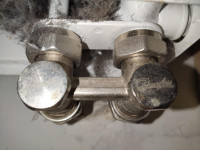Larsik300 wrote: Is there the correct valve under the caps?
the entire element in the first photo is a connection with shut-off valves, one on the supply and the other on the return.
There will be Allen keys under the nuts, which can be used to completely disconnect the radiator from the installation.
In practice, this valve is used to isolate the radiator from the installation for the duration of some renovation, maintenance, etc., or you can do the so-called orifice, i.e. limit the water flow and thus reduce the amount of heat the radiator will give.
In the second photo you have a thermostatic valve, which requires a thermostatic head to work properly, which is missing in your case.
The red element is used to make the so-called initial adjustment and setting the appropriate water flow.
You can limit the water flow only with the red element or additionally with those at the bottom in the first photo.
If you want the radiator to heat, you need a head, and if you want to "turn it off" completely, you turn both Allen keys on the lower connection and that`s it. But sometimes, after unscrewing these nuts, water may leak from the Allen key at the bottom. If the connection is functional, after unscrewing the nuts at the bottom, no water can leak there and it must be dry.




